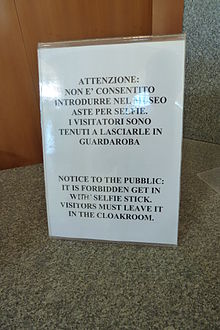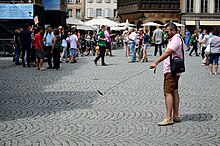Selfie stick
A selfie stick (also known as a selfie stick or selfie stick ) is a mostly telescopic stick that serves as an arm extension for the photographer . The main purpose of use is taking photos of oneself, that is to say creating a so-called selfie , with a camera, in particular a smartphone , which is mounted in a directionally adjustable manner on the end opposite the handle. The rod enables, for example, pictures of the photographer against a certain background or several people together by means of a somewhat more distant perspective.
application
The selfie stick is used by the photographer to extend his arm. This way, he can photograph himself in front of a larger background, at a different angle, or with a group without having to ask other people for help. The photographer operates the shutter release either on the pole where the smartphone is about one meter away, or via Bluetooth .
Poles, which are usually used for video recordings of runs or rides by a person with small action cams , must be more resistant to vibrations if they are attached to sports equipment such as bicycles, surfboards, snowboards or helmets. Holding the rod by hand allows more flexible selection of the recording direction, but also allows the lens to be cleaned of snow or splashes of dirt.
history
As the first forerunner of the selfie stick, the Japanese Hiroshi Ueda and Yujiro Mima patented a telescope extension for compact cameras in 1983 ; In the same year, Minolta launched the disc-7 camera with the so-called extender .
The Canadian Wayne Fromm came up with the idea of an extended holder for a smartphone in addition to remote control in 2002 . He first patented his invention in the United States in 2005 and has been selling it under the name Quik Pod since 2006 . The selfie stick achieved worldwide popularity in 2014, and Time Magazine ranked it among the 25 best inventions of 2014.
technology
Many manufacturers now offer selfie sticks. As a rule, this is an extendable rod that, depending on the model, can be extended to over 100 centimeters. One end, which is usually a bit thicker, is designed to be non-slip so that it can be gripped, while the other (upper) end has a clamp bracket for the smartphone - which can be articulated but can be fixed. This clamping takes place by frictional and form-fitting close to the four longitudinal edges, simulating approximately one-handed holding and leaving most of a smartphone side and thus a camera lens and accessories free. If the front camera lens is used, only a lower resolution is usually available, but the display can serve as a camera viewfinder to precisely define the image section. The camera can always be operated with the self-timer. However, this is a rather unfavorable practice. Selfie stick manufacturers try to make the triggering of an image comfortable for the user. There are various technical versions as alternatives:
While a monopod does not yet need a (ball) joint on the axial tripod thread for approximately horizontal shooting directions, the selfie stick near the camera needs at least a clampable articulation joint to allow different angular distances between the shooting direction and the hand holding the rod. For efficient rigidity against bending and vibrations, single and tripods have the large diameter of the telescopic extension at the top and thus close to the camera, but selfie sticks have this on the side of the handle, because in this case the highest buckling torque occurs.
trigger
Bluetooth remote control
The selfie stick does not have a trigger. The camera attached to the stick is operated using a remote control that communicates with the camera via Bluetooth technology. Some selfie sticks have a holder for the remote release. The range of such remote controls is about ten meters.
Bluetooth trigger
A picture trigger is integrated in the handle of the selfie stick. This trigger communicates with the camera via Bluetooth.
Trigger with cable connection
There is an image release button on the handle of the selfie stick. The picture release is connected to the headphone output of the smartphone attached to the pole with a jack plug.
Mounts
The scope of delivery of a selfie stick usually includes at least one, but with some models also several holders. These are available in different versions, which differ depending on the device to be attached. In most cases the following variants are used:
1/4 "external thread
Most selfie sticks have a 1/4 "external thread onto which the various smartphone and action cam holders can be screwed. In addition, it can be used to attach action cams, taking into account the maximum load capacity of the selfie sticks as well as compact and single-lens reflex cameras with an integrated 1/4 "internal thread.
Smartphone holder
The smartphone holder is a clamp holder in which smartphones of different sizes can be attached. This is either firmly attached to the selfie stick or is screwed onto a 1/4 "external thread. When purchasing, you should ensure that the supported minimum and maximum widths are compatible with your own smartphone.
Action cam bracket (quick release)
The brackets intended for action cams generally use a uniform quick release fastener that is used by the majority of action cam manufacturers. The action cam housing can be attached to this quick release fastener.
Others
In South Korea , selfie sticks must be approved by the relevant authorities before they can be sold. The reason for this is the radio signals generated by the Bluetooth function. The Ministry of Science and Technology in Seoul believes that these could interfere with technical devices and be harmful to health. The sale of unauthorized selfie sticks therefore faces fines of up to the equivalent of just under 22,000 euros or up to three years in prison.
controversy

Due to the rapid spread of the selfie stick, uncomfortable situations occur again and again, for example when fans are close to the track at bike races and endanger the riders by using the pole or when they are too close to valuable ones in museums with the pole Works of art come by. For this reason, selfie sticks are now banned in many public places.
In museums in particular, it is forbidden to take selfie sticks into many exhibition rooms around the world, for example in the Albertina in Vienna , in the Uffizi in Florence , the Vatican Museums and the Louvre . In the Kunsthistorisches Museum Vienna, on the other hand, selfies with poles are seen positively, as visitors identify with works and then share the images; They even offer workshops for selfie photography, referring to a self-portrait from 1523.
As in Europa-Park, the use of selfie sticks has not been allowed in the Walt Disney Parks since summer 2015.
The London football clubs Arsenal FC and Tottenham Hotspur have imposed a selfie stick ban on their stadiums. The reason for this is that the rod can be used as a weapon. In addition, the upward stretched cell phone obstructs the view of the football fans standing behind it. The organizers have also issued a ban on selfie sticks at the Wimbledon Grand Slam tennis tournament . The photo poles are also listed as prohibited items at some US music festivals .
The use of selfie sticks is prohibited in some American zoos and national and wildlife parks. This was mainly due to the reckless behavior of mostly younger park visitors, who often dare to get too close to the wild animals to take a selfie and thus provoke attacks. These include, for example, the Smithsonian National Zoological Park , the Central Park Zoo and Lake Tahoe , which has banned so-called "bear selfies".
literature
- Roman Bucheli: Recapturing the Self. How the selfie stick as an extended arm supports the optimization of the self-image. In: NZZ , March 28, 2015, p. 21.
Web links
- Markus Böhm and Sebastian Meineck: Photo phenomenon: Selfie stick - cool or embarrassing? In: spiegel.de , January 5, 2015, accessed on January 22, 2015.
Individual evidence
- ↑ Petra Vögele: A pole makes a career. In: Schwäbische Zeitung of January 16, 2015, p. 12.
- ↑ Patent US4530580 - Telescopic extender for supporting compact camera. In: google.de. Retrieved January 22, 2015 .
- ↑ MINOLTA DISC-7 CAMERA, 1983. ( Memento of the original from January 31, 2015 in the Internet Archive ) Info: The archive link was inserted automatically and has not yet been checked. Please check the original and archive link according to the instructions and then remove this notice. At: museumoftechnology.org.uk , accessed February 3, 2015.
- ^ Video from SRF April 22, 1983.
- ↑ Lena Schipper: The man who invented the selfie stick. In: faz.net. January 15, 2015, accessed January 22, 2015 .
- ↑ Leo Benedictus: Is this man responsible for inventing the selfie stick? In: theguardian.com. January 11, 2015, accessed January 22, 2015 .
- ↑ Nathan McAlone: Meet the man who invented the modern selfie stick, he's now a millionaire. In: businessinsider.com. August 5, 2015, accessed on July 12, 2020 .
- ↑ Statistical analysis for the search term selfie stick. In: Google Trends . Retrieved July 12, 2020 .
- ↑ Time 25 best inventions of 2014 ( English ) TIME INC. November 20, 2014. Retrieved November 28, 2014.
- ↑ Petra Vögele: A pole makes a career. In: Schwäbische Zeitung , January 16, 2015, p. 12.
- ↑ Raoul Wruck: Selfie Sticks - The Different Variants. In: myselfiestick.de , March 10, 2015, accessed on May 12, 2015.
- ↑ Selfie sticks: anyone who snaps goes to jail. (No longer available online.) In: chip.de. November 30, 2014, archived from the original on January 22, 2015 ; accessed on January 22, 2015 . Info: The archive link was inserted automatically and has not yet been checked. Please check the original and archive link according to the instructions and then remove this notice.
- ↑ Greg Keller: Selfie Sticks Forbidden. In: tagesanzeiger.ch . March 11, 2015, accessed June 1, 2016 .
- ↑ Museums prohibit selfie sticks. In: wien.orf.at. March 17, 2015, accessed June 1, 2016 .
- ↑ Selfie sticks are prohibited in Disney parks. In: spiegel.de. June 27, 2015, accessed May 1, 2016 .
- ↑ Europapark Rust prohibits selfie sticks. In: faz.net. July 4, 2015, accessed June 1, 2016 .
- ↑ The Self in Focus. In: weser-kurier.de . January 11, 2015, accessed June 1, 2016 .
- ↑ Petra Vögele: A pole makes a career. In: Schwäbische Zeitung , January 16, 2015, p. 12.
- ↑ Selfie sticks banned by Wimbledon bosses. In: telegraph.co.uk . April 27, 2015, accessed June 1, 2016 .
- ↑ No more selfie sticks at US festivals. In: rollingstone.de . March 30, 2015, accessed June 1, 2016 .
- ↑ https://nationalzoo.si.edu/visit/park-rules. Retrieved June 29, 2017 .
- ↑ Visitor Rules - Central Park Zoo. Retrieved June 29, 2017 .
- ↑ Jonathan Desabris: Lake Tahoe Officials Are Banning Bear Selfies ... Retrieved June 29, 2017 .


